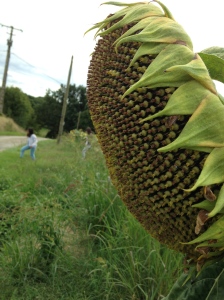Walking to Italian
I’m learning Italian, which is enchanting and frustrating in turns. The Italian is hard enough, but getting across town to my class has also had its challenges. On the morning of my first class, I decide to walk to Corso Vittorio Emanuele II, where the school is. I now live in a city where my husband’s name is everywhere – on streets and metro stations, even inside the Pantheon. Leaving the apartment on Via Romagna in haste, I quickly look up AA Routefinder to find the way, and head out into the October heat. Trouble is, I forgot to press ‘Walking Route’, and end up walking the driving route instead, straight down from the apartment, past the Japanese Embassy, down further towards the Piazza della Repubblica, then the entire length of Via Nazionale, to the Typewriter Building (also known as the National Monument to Vittorio Emanuele II . . .), and then another twenty minutes west along Corso Vittorio Emanuele II. When I finally arrive, hot and exhausted, an hour later, I find a bar and guzzle cold water, before letting myself into the ironworked elevator that goes up to Italia Idea. Whilst I’ve been married to the Italian for 12 years, and adopted two children with him, he has never spoken Italian to myself or the children. Of course, now that we’re all trying to learn it the hard way, we wish to heavan he had. But there was no persuading him, and so here we are in the Eternal City with our rubbish Italian. But I love my Italian class, it’s just getting there, that’s sometimes tricky. For the next class, I turned on my handy iPhone Satnav, and let myself be zig-zagged deftly from Via Romagna to Corso Vittorio Emmanuele in half an hour. For some reason, whilst I was out with Natalie trying to find a leotard shop (I know), the satellite broadband stopped working. I forgot this when I was off to class the next morning, and I also forgot the map. My striding confidence slowly waned, as I started to walk in circles, and because there are so many Vittorio Emanuele roads and piazzas, even when I asked for directions, I wasn’t sure if it was the right Vittorio Emanuele. Ten minutes before class, I give up and get a taxi. And so now I’m more careful, tentatively expanding and varying my route, but basically going down behind the American Embassy to Barberini, straight down Via Tritone, across in front of the parliament to the Pantheon, and on to the bottom of Piazza Navona, which is very close to the school. I love these walks. It’s like stumbling through the Renaissance, tripped up by regular demonstrations outside the parliament, and a thousand people carrying maps, and looking upwards.
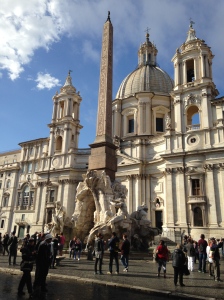
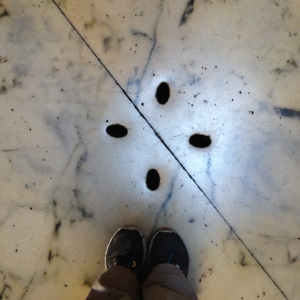
Our teacher is Alessandro, who used to do magic for kids’ parties before he trained to teach Italian as a foreign language. We know this, because sometimes, in the process of explaining something, he’ll do a trick – like making a cigarette disappear. It’s brilliant. I always ask him to do it again, but not very often, because it makes him go red. Bless. In our class, we have an Israeli woman, a Russian American, a Russian, an American, three French people and me. I usually sit beside Charles, who is 66, retired, and has been in Rome for three years. His wife works for Total, as do the husbands of Isabelle and Laeticia. The young American woman has a 6 month old baby, Laeticia’s children are 11 and 13, the Israeli woman’s are 9 and 5. Isabelle’s children are grown up, as are Charles’s first lot, the second lot are 9 and 14. So we are a group of mums, and Charles. I had lunch with the French women last week, they’re lovely. Isabelle was fifty this year, and her husband brought her a jag. I mentioned this to my husband, and he snorted into his coffee . . .
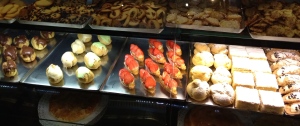
A few weeks ago we spent two entire lessons on different kinds of coffee. Now, for a girl who doesn’t drink coffee, this was stretching things a bit far. Our compiti (homework) involved putting together adjectives with different kinds of coffee: caffe lungo, ristretto, macchiato, whether you have it in a cup or a glass, whether the milk in your cappuccino is warmed or not. And the etiquette of coffee, apparently, no one in Italy drinks a cappuccino after lunch. We practice with acting out scenes in an Italian Bar – how you order what you want, what you might say. We listen to an audio scene, and have to answer questions about who gets what and why, who gives up the cornetto cioccolata for the child, who takes a fruit juice. Then there are the baked goods – the different kinds of cornetti (croissants) – semplice, mandorla, marmellata, crema; the doughnuts – the ciambelle (rings) the roundy ones (bombe). And then the juices, – the critical difference between a succo and a spremuta, how to choose between a tramezzino and a panini. We are armed and ready on a bright Thursday morning, when there are only three of us in the class – Charles, the Israeli woman and me. Off we go, out into the light for a class outing. Charles heads us straight towards his favourite pasticceria, where I get a barcetta fragola (a little pastry boat filled with custard and strawberries). Then we go to a bar where the others valiantly order coffee and I order green tea. It’s a great class.
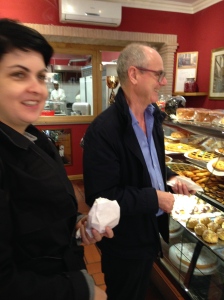
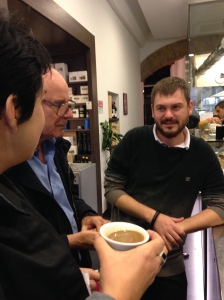
At breakfast this morning I wonder about sunflowers – which is ‘girasole’ in Italian – literally sunspinner. In the cold north of Europe, it makes sense that we don’t have this movement inside the language of the sunflower, because there aren’t fields of them moving their glorious faces to follow wide arcs of summer sun. And so, as I sprinkle girasole seeds on my cereal, extravagant slowly-spinning flowers haunt my mouthfuls.
